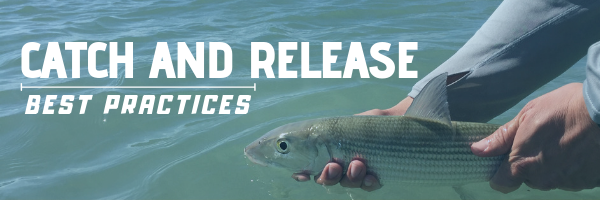Catch and release fishing has proven to be an invaluable tool in ongoing and increasingly popular conservation efforts.
With this technique, it’s been possible to both increase the number of bonefish available in the water, and improve their average size. Unfortunately, however, catching and then releasing a fish doesn’t always ensure its survival. In fact, if it’s not done properly, this practice can cause serious physical damages, while greatly increasing the likelihood of capture by common predators. Following are six easy ways to keep bones healthy and alive after these experiences.
Use Clean, Wet Hands
Proper handling starts with clean hands. You don’t want accidental contact with sunblock or any other solutions that you’ve been using to negatively impact the health of the fish. When handling bonefish, you’ll find that this impressive species is fully sheathed in a protective coating of slime. Removing too much of this slime can negatively impact a bone’s health. Thus, in addition to starting with clean hands, you also want to make every effort to avoid excessive handling. Keeping your hands wet throughout this process will keep the fish from drying out.
Hook Removal: Use A Hemostat Or Pliers While Keeping The Fish In The Water
To limit stress and discomfort, you’ll want to remove the hook as quickly and easily as possible. For assured success, avoid using barbed hooks altogether. Hook removal is best done with a pair of pliers or hemostat. You also want to keep the fish fully submerged during this process. With catch and release fishing, you never want to keep bonefish out of the water for more than 15 seconds.
Avoid Exposing The Fish To Air While Taking Photos
Don’t get carried away with picture-taking. The best catch and release photos are taken underwater. With the right camera, you can get amazing shots, prevent shock and distress, and keep bonefish from drying out.
Don’t Touch The Gills
Not only should you be mindful of the bone’s protective slime coating, but you also want to avoid touching the gills as well. Even moderate handling of these features can impede proper breathing by causing significant and possibly lasting gill damage.
Release Bonefish Away From Predators
One of the best ways to ensure the continued safety of a bonefish after catch and release is by letting the fish go in an area that’s free of predators. After all, even a truly hearty fish is virtually guaranteed to be in shock following this experience. The best way to safely release a bone is by avoiding waters that are rife with natural predators from the start. If predators have gathered in your area following a recent catch, think about keeping the bone in a live well until he can be released in a calmer area.
Shorten The Fight Time
Bonefish can quickly exhaust themselves in their efforts to get free. An exhausted bonefish that’s lost its equilibrium will often nose dive or roll over immediately after release. This behavior can make bones prime targets for savvy predators. It’s up to you to prevent this from happening. Try to land the fish before it has the chance to reach exhaustion. You should additionally choose tackle that reflects the condition and the size of the fish. If your efforts to shorten the fight time fail and a bone appears to have lost equilibrium, do not release it until it’s regained its ability to swim upright.









